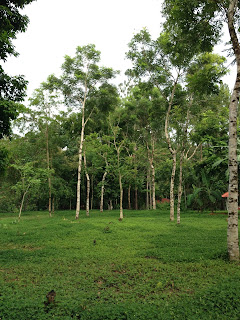Our last day in San Felix/David began with a presentation of our findings from our work in each of the three communities in the Comarca. Each group had a particular focus such as childhood development, women's health, or traditional medicine, and incorporated statistics and photos from each region. It was probably a little longer than needed, but I think we managed to hold the audience's attention through most of it!
Next on our agenda was an evening at the hospital in David, working alongside the Unachi nursing students doing their clinical rotations. The first half of the evening was pretty uneventful. There weren't a ton of patients on the floor, but my student, Cristela, and I got to hang blood and I did a head-to-toe assessment (in Spanish). Despite lack of hands-on work, I did learn a few things:
- Nurses (and students) hand write
everything! They don't have any electronic charting, it's all on paper.
- Mercury thermometers are really hard to read
- Counting respirations/pulses for 15 seconds and multiplying by 4 doesn't fly here
- Students sometimes have to work doubles (7a-11p!)
- And then they have to go home and do homework for their morning classes
- There is only 1 nurse per unit which means each one can have 30-40 patients at once!
(In the US, nurses complain when they have more than 5 patients)
- Nurses here make an average of $3/hour
(Meanwhile food, gas, and many other things are priced equivalently to the US)
- Students are
required to wear makeup and have their hair up in a neat bun
- All nurses wear little caps, and the various colors on them indicate where the nurse is from
(i.e. green = Panama City, yellow = Chiriqui)
- Regardless of where they're from or the language they speak, nursing students have the same sense of
humor :)
I really enjoyed my time working with the girls in David, and I wish we had more time to spend with them! They are held to such a high standard both academically and professionally, and I think they set a great example for nursing students everywhere. They were incredibly patient with us, taking the time to explain things several times in order to make sure we understood, and never seemed to mind that we couldn't speak their language. I, and I think we all, felt so welcome here that I can't wait to come back someday!
 |
| The students let us borrow their caps :) |
























































